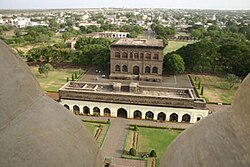| Bijapur - ವಿಜಾಪುರ | |
| | |
| | |
| Coordinates | 16°49′N 75°43′E / 16.82°N 75.72°E |
| Country | |
| State | Karnataka |
| District(s) | Bijapur District |
| District Collector | |
| Population • Density | 1,808,863 (2001[update]) • 172 /km2 (445 /sq mi) |
| Time zone | IST (UTC+5:30) |
| Area • Elevation | 10,541 km2 (4,070 sq mi) • 770 m (2,526 ft) |
Bijapur (Kannada: ವಿಜಾಪುರ Vijapur) city is the district headquarters of Bijapur District of Karnataka state. Bijapur city is well known for its historical monuments of architectural importance built during the rule of Adil Shahi dynasty. Bijapur is located 530 km northwest of Bangalore and about 550 km from Mumbai (Maharashtra).
The city was established in the 10th-11th centuries by the Kalyani Chalukyas and was known as Vijayapura (City of victory). The city came under the influence of the Khilji Sultanate in Delhi by the late 13th century. In 1347, the area was conquered by the Bahmani Sultanate of Gulbarga. By this time, the city was being referred as Vijapur or Bijapur.
History
In 1518, the Bahmani Sultanate split into five splinter states known as the Deccan sultanates, one of which was Bijapur, ruled by the kings of the Adil Shahi dynasty (1490-1686). The city of Bijapur owes much of its greatness to Yusuf Adil Shah, the founder of the independent state of Bijapur. The rule of this dynasty ended in 1686, when Bijapur was conquered during the reign of Mughal emperor Aurangzeb. In 1724 the Nizam of Hyderabad established his independence in the Deccan, and included Bijapur within his dominions. In 1760, the Nizam suffered a defeat by the Marathas, and ceded the region of Bijapur to the Maratha Peshwa. After the 1818 defeat of the Peshwa by the British in the Third Anglo-Maratha War, Bijapur passed into the hands of the British East India Company, and was assigned to the princely state of Satara.
In 1848 the territory of Satara, along with Bijapur, was annexed to Britain's Bombay Presidency when the last ruler died without a male heir. The British carved a new district by the name Kaladagi. The district included present-day Bijapur and Bagalkot districts. Bijapur was made the administrative headquarters of the district in 1885, when the headquarters were moved from Bagalkot. After India's Independence in 1947, the district became part of Bombay state, and was reassigned to Mysore State, later Karnataka, in 1956. The former southern taluks of the district were separated in 1997 to form Bagalkot District.
Description
The city consists of three distinct portions: the citadel, the fort and the remains of the city. The citadel, built by Yusuf Adil Shah, a mile in circuit, is of great strength, well built of the most massive materials, and encompassed by a ditch 100 yards (91 m) wide, formerly supplied with water, but now nearly filled up with rubbish, so that its original depth cannot be discovered. Within the citadel are the remains of Hindu temples, which prove that Bijapur was an important town in pre-Islam times. The fort, which was completed by Au Adil Shah in 1566, is surrounded by a wall 6 m. in circumference. This wall is from 30 to 50 ft (15 m) high, and is strengthened with ninety-six massive bastions of various designs. In addition there are ten others at the various gateways. The width is about 25 ft (7.6 m); from bastion to bastion runs a battlemented curtained wall about 10 ft (3.0 m) high. The whole is surrounded by a deep moat 30 to 40 ft (12 m) broad. Inside these walls the Bijapur kings bade defiance to all comers. Outside the walls are the remains of a vast city, now for the most part in ruins, but the innumerable tombs, mosques, caravanserais and other edifices, which have resisted the havoc of time, afford abundant evidence of the ancient splendour of the place. Badami, Aihole, and Pattadakal, near Bijapur, are noted for their historical temples in the Chalukya architectural style.
Attractions

Bijapur is rich in historical attractions, mainly related to Islamic architecture, especially those of the Bijapur Fort.
- Gol Gumbaz: This is the most famous monument in Bijapur. It is the tomb of Mohammed Adil Shah (ruled 1627-1657). It is the second largest dome ever built, next in size only to St Peter's Basilica in Rome. A particular attraction in this monument is the central chamber, where every sound is echoed seven times. Another attraction at the Gol Gumbaz is the Whispering Gallery, where even minute sounds can be heard clearly 37 metres away. Gol Gumbaz complex includes a mosque, a Naqqar Khana (a hall for the trumpeters) (Now it is used as museum) and the ruins of guest houses. We can see the rough model of golgumbaz in a village called Mahal. It is just 8km from the golgumbaz.
- Ibrahim Rauza: This is the tomb of Ibrahim Adil Shah II (ruled 1580-1627), the fifth king of the dynasty and, like the Mughal emperor Akbar, known for religious tolerance. Built on a single rock bed, it is noted for the symmetry of its features. It is said that the design for the Ibrahim Rauza served as an inspiration for that of the famous Taj Mahal.
- Malik-e-Maidan (The Monarch of the Plains) the largest medieval cannon in the world. Being 4 m long, 1,5 m in diameter and weighing 55 tons, this gun was brought back from Ahmadnagar in the 17th century as a trophy of war by 400 oxen, 10 elephants and tens of men. It was placed on the Sherza Burj (Lion Gate) on a platform especially built for it. The cannon's nozzle is fashioned into the shape of a lion's head with open jaws & between the carved fangs is depicted an elephant being crushed to death. It is said that after igniting the cannon, the gunner would remain underwater in a tank of water on the platform to avoid the deafening explosion. The cannon remains cool even in strong sunlight and if tapped, tinkles like a bell. In 1854 the cannon was auctioned for Rs. 150 but the sale was cancelled in the end.
- Upri Buruj, Built around 1584 by Hyder Khan, is an 80 ft (24 m) high tower standing to the north of Dakhani Idgah in Bijapur. This is a spherical structure with stone steps winding round the outside. Top of the tower offers a commanding view of the city. This is also known as Hyder Burj, Upli Burj. On top of Upli Burj there are two guns of huge size. The parafeet this tower which was used for monitoring purposes has been fenced now. One needs to climb the circular stairs to reach the top. However except for this tower there is very little evidence of the citadel wall in this area due to rampant construction.
- Chand Bawdi, Ali Adil Shah (1557-1580) built this tank near eastern boundary of Bijapur. When there was large influx of people into Bijapur after the fall of the Vijayanagar empire, and new settlements came up within the walled city raising the need for better infrastructure and providing water supply. This has a storage capacity of 20 million litres. Later it became a model for many other tanks constructed in the city. A grandeur complex came up around it, which was mainly used to house the maintenance staff though members of the royal family occasionally used it for recreation. He named this after his wife "Chand Bibi".
- Asar Mahal, The Asar Mahal was built by Mohammed Adil Shah in about 1646, which was used to serve as a Hall of Justice. The building was also used to house hairs from the Prophet's beard. The rooms on the upper storey are decorated with frescoes and the front is graced with a square tank. Here women are not allowed inside. Every year there is urs (festival) held at this place. In front of the hall, one can see three tanks the bigger tank, which is at the centre is about 15 feet (4.6 m) deep however the other two are comparatively smaller in size as well as depth. Behind Asar Mahal one can still see the remain of the citadel. Just a kilometer away behind Asar Mahal, one can still find the old mosque which is on top of the citadel wall. There is a big entrance with arc below this mosque. Many stones have inscriptions. The site is under maintenance of Archeological Survey of India.
- Gagan Mahal, Which means Sky Palace, is built with a 21- meter façade and four wooden massive pillars, has a majestic central arch. Sikandar Adil Shah, in silver chains, surrendered to Aurangzeb in 1681 here.
- Barakaman (Ali Roza-II) A mausoleum of Ali Roza built in 1672. It was previously named as Ali Roza, but Shah Nawab Khan changed its name to Bara Kaman as this was the 12th monument during his reign. It has now seven arches and the tomb containing the graves of Ali, his queens and eleven other ladies possibly belonging to the Zenana of the queens.
- Among the other historical attractions at Bijapur, some notable ones are the Anand Mahal, Jod Gumbaz, Jumma Mosque, Sat Manzil, and Jal Manzil. Also among old houses at Bijapur, the most famous is Elavia House ( Nauzer Elavia) which is more than 100 years old.
- Saat Kabar, meaning sixty graves, is a site which can aptly be called as the 'dark tourist spot'. Saat Kabar may not have any intricate or wonderful architectural characteristics like the Gol Gumbaz or Ibrahim Roza to offer to its visitors, but the heart-rending story it narrates makes it a spot worth visiting. This heritage site tells the story of a passionate army chief who killed his 63 wives fearing they would remarry after his death. Afzal Khan, the army chief of Ali Adil Shahi-II of the Adil Shahi Dynasty that ruled Bijapur for four centuries, cold bloodedly murdered all his wives, one by one, before setting out on a battle with Chatrapati Shivaji, the great Maratha warrior, at Pratapgad in Maharashtra in 1659. Sick of continuous attacks by Aurangzeb on one side and Shivaji on the other side, Ali Adil Shahi-II ordered Afzal Khan to contain these two enemies to protect the empire. Although known for his bravery, Khan was a firm believer in astrology. He always consulted soothsayers before setting out on a war. When an astrologer predicted about his defeat and sure death in the battle against Shivaji, he decided to kill all his wives so that they would not remarry after his death. Hence he led all his wives to a huge well in a lonely place on the outskirts of the city and pushed them into it one after another. Later, he buried their bodies near the well. Seeing this horrifying act, two of his wives tried to escape, but in vain. They were chased and killed by soldiers, reveal historical records.


























